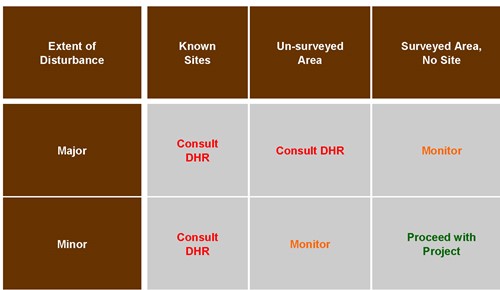DHR Matrix for Ground Disturbance on State Lands
Archaeological Resource Management (ARM)-trained monitors are no longer permitted to perform any "pre-testing" or to collect any artifacts. In 2013 DHR sent a memo to each state agency describing changes to ARM training for agency-wide distribution (review the 2013 memo (pdf). If you were trained prior to 2012, we encourage you to take a refresher course as the matrix has changed. The most significant change to the matrix is the elimination of the "moderate" category. Reclassifying undertakings formerly termed "moderate" resulted in a simpler, more effective matrix. Archaeological Resource Management courses now focus on promoting awareness of historical resources and documenting sites through field notes and photographs.
The matrix is a tool designed to help streamline the Division of Historical Resources Compliance and Review process for state land managers. Ground disturbing activities are part of regular and necessary land management, and these activities have the potential to permanently damage historical resources. According to Sections 267.061(2)(a,b), Florida Statutes, state agencies shall consult the Division of Historical Resources prior to undertakings and allow the Division a reasonable opportunity to comment.
How to use the matrix:
- Determine if a disturbance is Minor or Major by consulting the lists of undertakings:
| MINOR DISTURBANCES | MAJOR DISTURBANCES |
|---|---|
| Bicycle racks | Prescribed burns (initial) |
| Cable burial with blade-type devices | Mechanized exotic plant removal (not hand pulling) |
| Campsite markers | Concrete slab installation |
| Emergency holes (for safety, accident or emergency repairs) | Docks |
| Fireplaces/grills | Dredging |
| Flagpoles | Public utilities (trenched) |
| Garbage can or recycle bin posts | New fire line construction |
| Gardening (existing activity) | Beach construction |
| Horse hitching posts | Initial roller chopping |
| Kiosks on post | Sewage treatment plant construction |
| Lifeguard stands | Water/sewer line installation |
| Lightning arresters | Tree trunk removal (big trees) |
| Plantings (shrubbery, seedlings or plugs) | Tree or big plant planting or root ball removal |
| Poles for utilities, lights, speakers | Drainage swale construction |
| Prescribed burns (not initial)* | Foundation repair or stabilization |
| Road/trail barriers & signs | Mobile home installation |
| Roller chopping (light-empty tank) | Telephone lines (trenched) |
| Sign posts | Terracing for erosion control |
| Fire ring installation | Water retention area construction |
| Boardwalks, catwalks or piers | Septic tank/drain field installation (new or enlargement) |
| Equipment racks | Bridge Construction |
| Fire lane maintenance* | Garden installation (new areas) |
| Playground equipment installation | Animal burials |
| Temporary open shelter construction | Trenching |
| Septic tank/drainage (replacement, no enlargement) | Clivis (restroom) installation |
| Stabilizing existing unpaved roads (not historic roads)* | Sidewalk installation |
| Unpaved road maintenance (disking, harrowing, plowing, etc.) | Picnic shelter with slab |
| Decks or Platforms | Borrow pits |
| Drainage swale maintenance* | |
| Fence posts and railings | |
| Parking lot boundary posts | |
| Monument construction | |
| Tower construction | |
| Well drilling (includes catchment basins) |
*If the matrix calls for monitoring, long or linear projects are best monitored by doing a walkover before or after the undertaking.
- Determine if the project area has been surveyed and if archaeological sites exist by contacting the Florida Master Site File.
- Consult the ground disturbance matrix:
Matrix

If you need to consult DHR or monitor, fill out the appropriate form and send it to Compliance and Review.
Consult DHR = Complete a DHR Consultation Form and send it to the Compliance and Review Section at [email protected].
Monitor = Actively observe ground disturbance and, if needed, stop construction and alert DHR. Report your results to DHR by sending a Monitoring Results Transmission Form to the Compliance and Review Section at [email protected]. Only professional archaeologists and land managers who are ARM-Certified (have successfully completed DHR's Archaeological Resource Management Training course) may act as archaeological monitors. ARM Monitors shall not collect artifacts but will document them in place with photographs and notes.
If any questions arise, call the Bureau of Archaeological Research at 850.245.6444.

